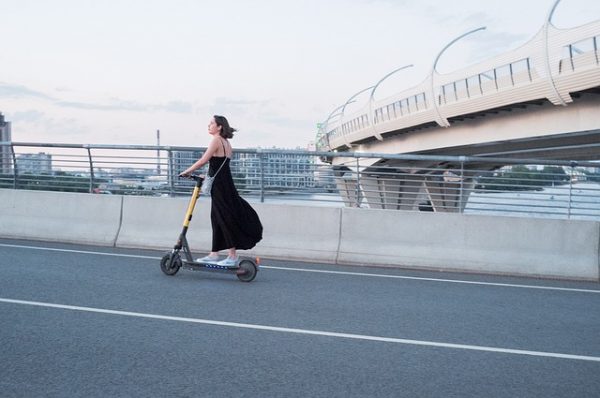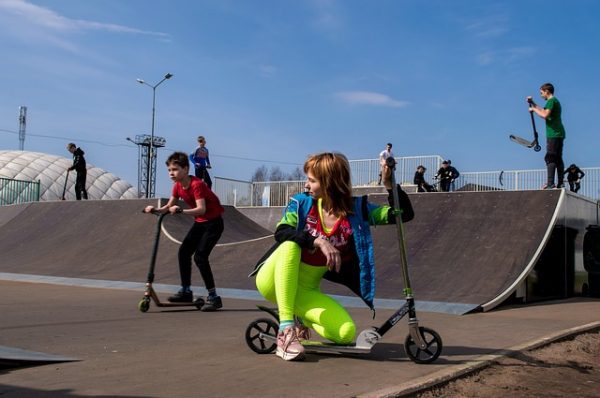As we journey through life, we’re constantly looking for engaging and innovative ways to foster critical thinking skills, especially in our young ones.
Have you ever considered the humble scooter as a tool for cognitive development and problem-solving? From electric, foldable, and stunt scooters to tricycles, kick scooters, and balance boards, scooting offers a variety of options to explore.

It may seem like just a fun activity, but scooting can help build confidence, enhance spatial awareness, and foster creativity. It’s not merely about getting from point A to B, but about navigating the journey, making decisions, and overcoming obstacles. Plus, it’s a fantastic way to make learning fun!
Not to mention, scooting offers some incredible health benefits too. Of course, safety is paramount, so we’ll also discuss important safety measures to take while scooting.
Key Takeaways
- Scooting fosters critical thinking skills, problem-solving, decision-making, and understanding of cause and effect.
- Scooting promotes motor skills development through balance, coordination, and spatial awareness.
- Scooting encourages creativity, imaginative play, and social interaction.
- Scooter games enhance problem-solving, critical thinking, quick thinking, and strategic decision-making skills.
Understanding The Basics Of Scooting
You’ve got to get the hang of the basics of scooting and trust me, it’s not only thrilling but also a nifty way to spark up your problem-solving skills. This engaging activity requires an understanding of scooter mechanics and a pinch of scooter history.
The mechanics encompass how the wheels, handlebars, and deck work together for controlled movement. Scooter history, on the other hand, provides a fascinating insight into how our modern-day scooters evolved from simple wooden planks. Armed with this knowledge, you can efficiently maneuver your scooter, making quick decisions and solving problems on the go.
Safety is paramount, so always remember to put on protective gear. Ready to explore further? Let’s delve into the fascinating link between scooting and cognitive development.
The Link Between Scooting & Cognitive Development
Believe it or not, zipping around on two wheels can foster significant cognitive growth in children. Scooter mechanics themselves offer a wealth of learning opportunities.
- Motor Skills Development: Maneuvering a scooter requires balance, coordination, and spatial awareness.
- Problem-Solving And Decision Making: Choosing when to speed up, slow down, or change direction is constant cognitive stimulation.
- Understanding Cause And Effect: Experiencing the consequences of their actions firsthand, like the fact that going too fast can lead to falls, helps kids grasp this fundamental concept.
Encouraging your child to scoot isn’t just about physical activity—it’s also about nurturing their mind. And as they master the art of scooting, they’ll be paving the way for building confidence and independence.
Building Confidence & Independence

As your little one glides confidently down the sidewalk, they’re not just learning to navigate a new mode of transportation, they’re also discovering the exhilarating feeling of self-reliance and personal achievement.
This simple act of scooting promotes autonomy, encouraging them to take charge of their journey. We’re here to guide and ensure their safety, but ultimately, it’s the child who decides the direction and pace. This is a great opportunity for building resilience, as they’ll inevitably encounter bumps in the road, but they’ll learn to get up, dust off, and continue scooting.
This newfound independence and confidence will undoubtedly spill over into other areas of their life. Moving forward, let’s explore how scooting can also be instrumental in enhancing their spatial awareness.
Enhancing Spatial Awareness
Navigating on their wheels, little ones quickly grasp the concept of spatial awareness. Scooter navigation skills are a fun and engaging way to enhance this crucial cognitive ability. It’s more than just a game; it’s a way of understanding the world around them.
- Scooter obstacle courses: Setting up simple obstacle courses allows children to maneuver their scooters through different paths. This helps them understand distance, direction, and spatial relationships.
- Directional games: Playing games that involve following directions can improve both their listening and spatial skills.
- Mapping routes: Encourage them to map out their scooter routes. This promotes an understanding of spaces and how they connect.
As they master these skills, they’re unknowingly setting the stage for the next exciting benefit of scootering – fostering creativity.
Fostering Creativity
Imagine your child zipping around on their wheels, the wind in their hair, as they brainstorm unique paths and routes, sparking their innate creativity. They’re not just scooting; they’re engaging in an act of artistic expression.
The world becomes their canvas, and the scooter, their brush. The twists and turns they take trigger imaginative play, encouraging them to think outside the box and view their surroundings from a different perspective. As they navigate their path, they’re learning to problem-solve creatively.
Just remember, safety is paramount. Ensure they’re equipped with a helmet and protective gear. By fostering creativity in this way, we’re helping children develop invaluable life skills.
Next, we’ll discuss how scooting can also serve as a fun social activity.
Scooting As A Social Activity
While encouraging creativity through scooter use is essential, it’s not the only benefit scooters bring. They can also be a powerful tool to foster social interactions and connections.

- Group rides are not just fun, they’re an excellent opportunity for children to learn and practice social skills. They can engage in conversation, cooperate to navigate routes, and build a sense of community.
- Scooter etiquette is paramount during group rides. It teaches children respect for others’ space and safety while fostering a sense of responsibility.
- Engaging in scooter activities can help children develop empathy as they learn to assist others in mastering scooter skills or comfort friends who might have taken a tumble.
With these social benefits in mind, let’s explore how we can inject a dose of fun into learning through scooters.
Making Learning Fun With Scooters
As we delve deeper into the fascinating world of scooters, let’s explore how they can make learning fun and engaging. By incorporating scooters into educational games, we’re not just encouraging physical activity but also promoting cognitive development.
And what’s even better, the skills learned can be directly applied to real-world situations, making the learning process more meaningful and effective.
Incorporating Scooters In Educational Games
You’ll find that integrating scooters into educational games can significantly enhance your child’s problem-solving skills and critical thinking. Scooters offer a unique platform for fun, engaging, and safe learning experiences.
- Scooter Races – A friendly competition where kids navigate through a course. This encourages them to think quickly and make strategic decisions.
- Educational Obstacles – Incorporate questions or challenges that need solving to progress in the game. This promotes active engagement and cognitive development.
- Team-Based Games – Promotes cooperation, communication, and collective problem-solving.
- Game Variations – Modify games to keep them exciting and challenging. This fosters adaptability and resilience.
Our approach is rooted in safety, enjoyment, and continuous learning. It’s not just about winning; it’s about developing and applying critical thinking skills.
Next, we’ll explore how these learned skills can be utilized in real-world situations.
Applying Learned Skills In Real-world Situations
Having explored how we can creatively incorporate scooters into educational games, let’s now delve into the practical applications of these new-found skills. Using a scooter not only helps to develop physical strength and coordination but also encourages skill transferability. This means that the problem-solving tactics and critical thinking we’re fostering with these fun scooter games can be directly applied to real-world situations.
For instance, navigating a scooter through obstacles can be likened to tackling life’s challenges. The ability to make quick decisions, adapt strategies, and maintain balance are all vital life skills that we’re subtly reinforcing. The value of using a scooter in this capacity is truly multi-faceted.
Now, let’s take a look at how scooting also contributes to our physical health and wellness.
The Health Perks Of Scooting
Scooting not only fuels your problem-solving skills, but it also offers a myriad of health benefits, boosting your overall well-being.
It’s a fun way to engage in physical activity, helping us to maintain a healthy weight and promote heart health.
The various scooting postures we adopt while navigating different terrains also enhance our balance and coordination.
Scooter customization is another exciting aspect. It allows us to personalize our ride to fit our unique needs, serving as a creative outlet that also improves our hand-eye coordination.
Remember, safety is essential when scooting. Proper helmet usage, knee and elbow pads, and reflective gear can greatly minimize potential injuries.
In our next section, we’ll delve deeper into the importance of these safety measures while enjoying our scooting adventures.
Safety Measures While Scooting
While we all enjoy the health and mental benefits of scooting, we mustn’t overlook the importance of safety.
Always remember, wearing a helmet is not an option, but a necessity – it’s our primary line of defense against unforeseen accidents.
Furthermore, adhering to safe scooting practices, like avoiding busy roads and practicing control, can significantly reduce risks and ensure we continue to enjoy scooting in the safest way possible.
Importance Of Wearing A Helmet
Don’t overlook safety, folks; always wear a helmet when you’re out and about on your scooter. We’re not just saying this to scare you, but to ensure your wellbeing. Let’s break down the importance of a helmet:
- Helmet Legislation:
- Many regions have legislation requiring helmet usage. Don’t just see it as a rule but as an act of self-care.
- Helmet laws aim to protect riders from possible severe injuries, so it’s crucial to respect them.
- Helmet Designs:
- Helmets come in various designs that ensure comfort and style while safeguarding your head.
- They’re equipped with features like adjustable straps and inner padding for a secure fit.
Remember, your safety should never be compromised. Now, let’s glide into the guidelines for safe scooting practices.
Safe Scooting Practices

Ensuring your safety when you’re zipping around on your two-wheeler involves more than just sporting a helmet. It’s about adopting conscious riding habits and adhering to traffic rules.
We need to prioritize scooting etiquette, understanding that sidewalks and streets are shared spaces. Always be mindful of pedestrians, give way when necessary, and signal before turning.
Mastering traffic navigation is equally vital. We must obey traffic lights, use scooting lanes when available, and never ride against the flow of traffic. It’s all about creating a safe environment for everyone.
Remember, our ultimate goal is to use scooting as a fun tool for problem-solving and critical thinking development, so let’s keep it safe and enjoyable.
Now that we’ve covered safety, let’s shift our focus to how to pick the perfect scooter for this exciting journey.
Choosing The Right Scooter
When it comes to scooting, choosing the right scooter is paramount. We need to consider several factors like the scooter’s durability, size, and design before making a purchase.
But it doesn’t end there, it’s equally important to understand how to maintain and take care of your scooter to ensure its longevity and your safety.
Factors To Consider When Buying A Scooter
You’ll need to weigh a variety of factors before purchasing a scooter. These factors include your budget, the scooter’s durability, its size relative to the rider, and the type of terrain it’ll be used on. Consider the scooter’s durability, as it’s crucial for longevity and safety. Some scooter brands are renowned for their robust build and quality materials, so research is key.
Remember, a scooter that’s too big or too small can pose safety risks and hinder the rider’s ability to maneuver effectively. And don’t forget about the terrain. An off-road scooter might be better for rougher surfaces, while a standard scooter is perfect for smooth, paved areas.
Once you’ve made your decision, it’s time to focus on keeping your scooter in good shape, which means proper maintenance and care.
Maintaining And Caring For Your Scooter
Maintaining your two-wheeler isn’t just about longevity—it’s also about ensuring top-notch performance and safety every time you hit the pavement. We can’t stress enough the importance of regular checks and tune-ups.
Keep an eye on the brakes, tires, and battery life. And don’t forget scooter customization—it’s not just about aesthetics, it’s about making your ride truly yours and fitting it to your needs.
Now, let’s talk protective gear. Helmets, knee, and elbow pads are your faithful companions on each ride. They shield you from potential harm and believe us, they’re worth every penny.
Caring for your scooter and gear is an act of service to yourself. When you protect what’s important to you, you’re also indirectly helping others by setting a worthy example of responsibility and safety.
Conclusion
We’ve seen how using a scooter can boost problem-solving skills and nurture critical thinking. It’s a fun, creative activity that builds confidence, enhances spatial awareness, and even offers health benefits.
Not only can you find the perfect scooter for you, but you can also get helpful tips, connect with other riders, and get access to exclusive deals. Always remember, safety first when scooting! So, let’s pick the right scooter and start this exciting, learning-filled journey.
Scoot on, friends! If you enjoyed this article, please leave a comment or share it on social media. Let’s join forces to spread the love of scooting and keep this amazing pastime alive!
Frequently Asked Questions (FAQs):
What Makes A Scooter Work?
What Is The Problem With Electric Scooters?
The electric scooter presents a range of benefits for short trips and addresses the last mile problem, but it also faces certain challenges compared to cars.
- Limited Range and Battery Life: Electric scooters typically have a limited range due to their battery capacity. This can be a drawback for users who need to travel longer distances or have frequent trips throughout the day. Additionally, the battery life of scooters may vary, and if not properly managed, it can lead to unexpected interruptions during journeys.
- Safety Concerns: While electric scooters can be a convenient mode of transportation for short trips, they do pose safety concerns. Riders need to navigate through mixed-traffic environments, sharing the road with larger vehicles. The lack of physical protection and relatively small size can make riders more vulnerable to accidents, particularly in areas with heavy car traffic.
- Infrastructure Limitations: The infrastructure for electric scooters is still developing in many cities. Dedicated lanes, charging stations, and parking facilities specifically designed for scooters may be insufficient or nonexistent, making it challenging for riders to find suitable spaces for parking and charging. This can lead to issues such as sidewalk clutter or improper parking, affecting pedestrians and creating inconvenience.
- Weather Dependency: Electric scooters are exposed to weather conditions, making them less favorable during inclement weather, such as rain, snow, or extreme temperatures. This weather dependency can reduce their usability and convenience, particularly for individuals relying on them for daily commuting or longer distances.
- Last Mile Problem and Accessibility: Electric scooters are often promoted as a solution to the last mile problem, providing a convenient option for covering short distances after using other modes of public transportation. However, their effectiveness in addressing this problem can be limited by factors such as uneven distribution, availability, and accessibility of scooters, particularly in certain neighborhoods or areas with limited access to charging infrastructure.
In other words, while electric scooters offer benefits for short trips and can help address the last-mile problem, they also face challenges. These include limited range and battery life, safety concerns when sharing the road with cars, infrastructure limitations, weather dependency, and considerations related to the accessibility and availability of scooters. Addressing these issues through proper regulations, infrastructure development, and user education can help maximize the potential benefits of electric scooters while mitigating their drawbacks.
Are Scooters Efficient?
Scooters can be considered efficient, particularly when it comes to covering short distances and achieving moderate speeds. Here’s why:
- Speed and Maneuverability: Scooters are designed to be nimble and offer good acceleration. They are well-suited for navigating through congested areas and weaving through traffic. Scooters can achieve speeds that are typically higher than walking or even biking, making them efficient for short trips when time is a consideration.
- Time Efficiency: Scooters can save time compared to walking, especially when traveling medium distances. They offer a faster mode of transportation, allowing individuals to reach their destinations more quickly. This time efficiency is particularly valuable in urban areas where traffic congestion and longer walking distances may slow down the overall travel time.
- Reduced Effort: Using a scooter requires less physical effort compared to walking longer distances. By utilizing the scooter’s motor power, riders can conserve energy and cover ground with less exertion. This efficiency can be beneficial for individuals who want to reach their destinations faster without exerting excessive physical effort.
- Range and Battery Life: Electric scooters, in particular, can be efficient in terms of range and battery life. While the range may vary depending on the scooter model and battery capacity, they are generally designed for short to medium distances. Electric scooters typically offer enough battery life to cover several miles on a single charge, making them suitable for commuting or running errands within a limited radius.
However, it’s important to note that scooters may not be as efficient as other modes of transportation, such as cars or public transportation when it comes to longer distances or high-speed travel. Additionally, factors such as traffic conditions, charging infrastructure availability for electric scooters, and the rider’s skill and familiarity with riding a scooter can also impact overall efficiency.
In conclusion, scooters can be considered efficient for short to medium distances and moderate speeds. They offer a faster mode of transportation compared to walking and can save time and physical effort. However, their efficiency may vary depending on factors such as distance, traffic conditions, and the specific capabilities of the scooter being used.
Why Do People Need Scooters?
What Is The Benefit Of Playing Scooter?
A variety of individuals use scooters, including those who also walk as a means of transportation. Here are some examples:
- Commuters: Scooters are often used by commuters who need to travel relatively short distances. For individuals who prefer not to rely solely on walking, scooters provide a convenient and efficient alternative. They can cover more ground while still enjoying the flexibility and maneuverability offered by walking.
- Students: Many students use scooters as a means of transportation on college or university campuses. Scooters allow them to move quickly between classes and other campus locations, providing a faster option than walking alone. They offer a practical solution for students who want to save time and energy while navigating large campuses.
- Tourists: Scooters are popular among tourists exploring cities and attractions. They allow visitors to cover more ground and easily navigate through busy areas, providing a more efficient mode of transportation compared to walking long distances. Scooters offer tourists the flexibility to explore various destinations without tiring themselves out on foot.
- Urban Residents: People living in urban areas often use scooters as part of their transportation mix. While walking remains a common mode of transportation for short distances, scooters offer an added level of convenience and speed. They can be particularly useful when traveling to locations that are slightly farther away or when time is a consideration.
- Delivery Workers: Scooters are also utilized by delivery workers for quick and efficient delivery service
